AF4S31: Financial Accounting Report - Tesco and Benedict Co. Analysis
VerifiedAdded on 2022/08/18
|17
|4454
|10
Report
AI Summary
This report provides a comprehensive analysis of strategic financial accounting, focusing on Tesco's 2016 annual report and the financial performance of Benedict Co. The first part of the report examines Tesco's stakeholder relationships, including suppliers, customers, and colleagues, and assesses the company's environmental and social review and corporate governance practices. The second part delves into the financial analysis of Benedict Co., utilizing various financial ratios such as gross profit ratio, net profit ratio, current ratio, and debt-to-equity ratio. The report explains the purpose and relevance of these ratios, analyzes the results and movements between two years, identifies aspects of performance causing concern, and evaluates the application of financial ratios in assessing the company's financial health. The analysis includes profitability, liquidity, and efficiency ratios, providing insights into the company's financial position and performance.
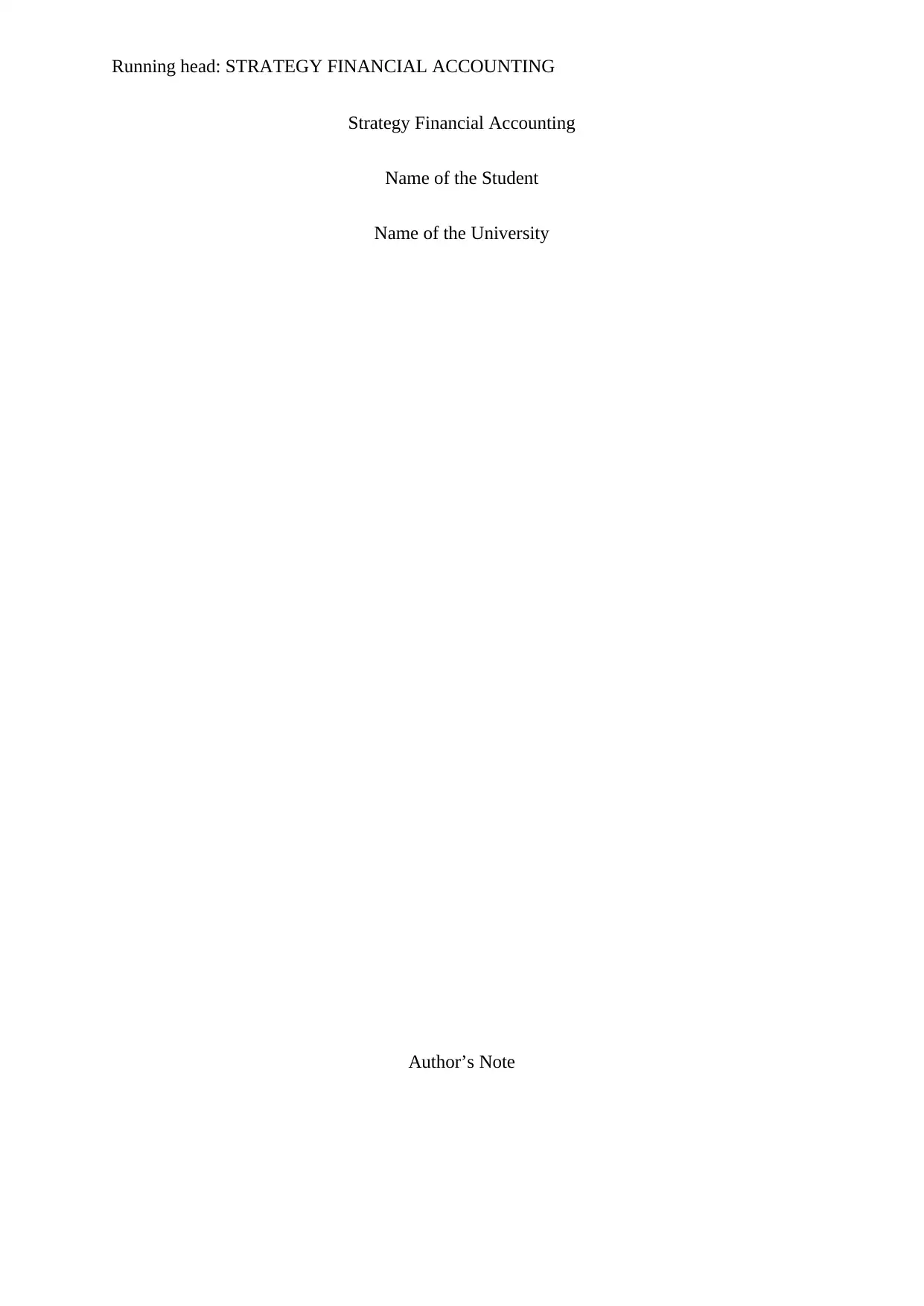
Running head: STRATEGY FINANCIAL ACCOUNTING
Strategy Financial Accounting
Name of the Student
Name of the University
Author’s Note
Strategy Financial Accounting
Name of the Student
Name of the University
Author’s Note
Paraphrase This Document
Need a fresh take? Get an instant paraphrase of this document with our AI Paraphraser
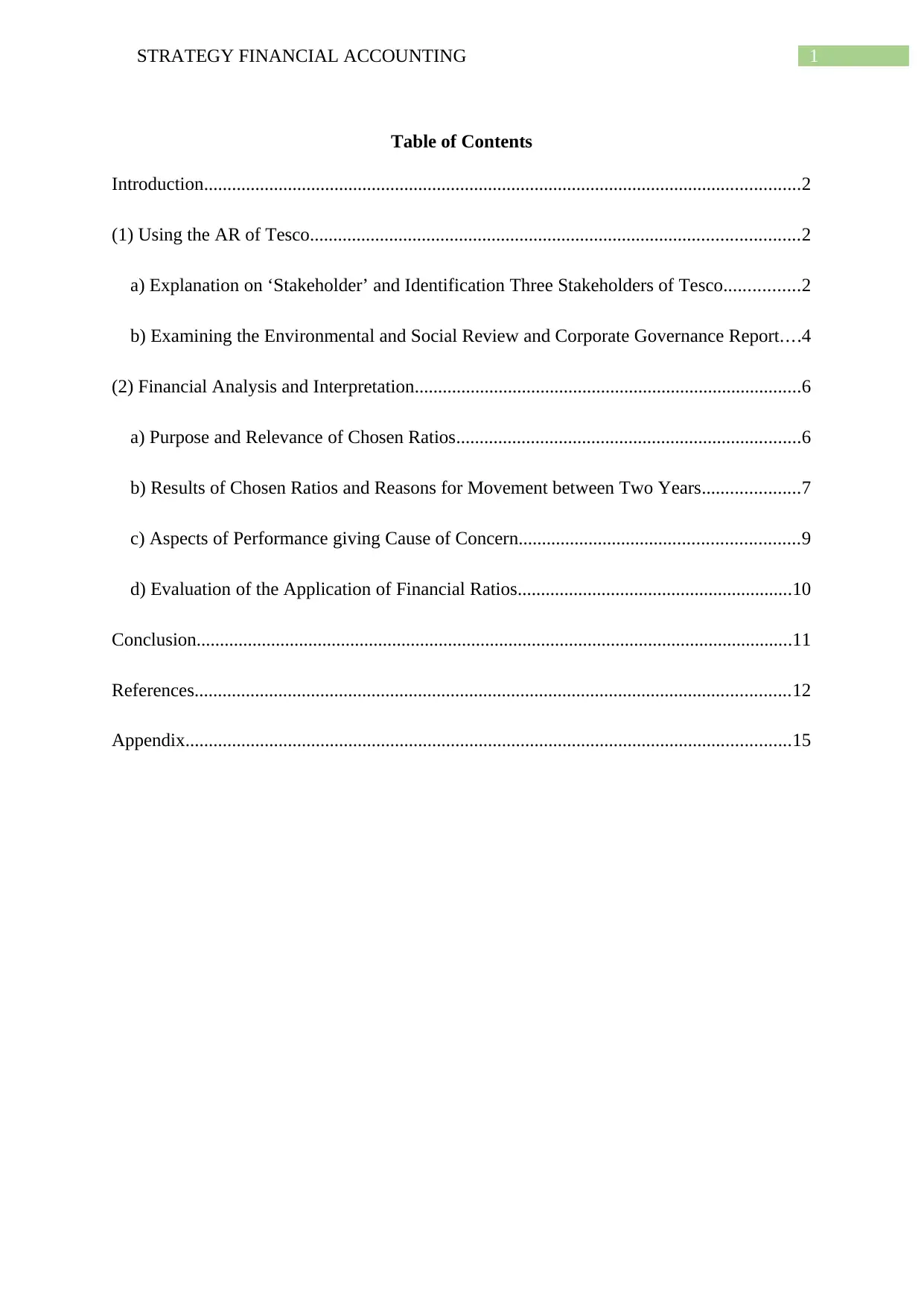
1STRATEGY FINANCIAL ACCOUNTING
Table of Contents
Introduction................................................................................................................................2
(1) Using the AR of Tesco.........................................................................................................2
a) Explanation on ‘Stakeholder’ and Identification Three Stakeholders of Tesco................2
b) Examining the Environmental and Social Review and Corporate Governance Report....4
(2) Financial Analysis and Interpretation...................................................................................6
a) Purpose and Relevance of Chosen Ratios..........................................................................6
b) Results of Chosen Ratios and Reasons for Movement between Two Years.....................7
c) Aspects of Performance giving Cause of Concern............................................................9
d) Evaluation of the Application of Financial Ratios...........................................................10
Conclusion................................................................................................................................11
References................................................................................................................................12
Appendix..................................................................................................................................15
Table of Contents
Introduction................................................................................................................................2
(1) Using the AR of Tesco.........................................................................................................2
a) Explanation on ‘Stakeholder’ and Identification Three Stakeholders of Tesco................2
b) Examining the Environmental and Social Review and Corporate Governance Report....4
(2) Financial Analysis and Interpretation...................................................................................6
a) Purpose and Relevance of Chosen Ratios..........................................................................6
b) Results of Chosen Ratios and Reasons for Movement between Two Years.....................7
c) Aspects of Performance giving Cause of Concern............................................................9
d) Evaluation of the Application of Financial Ratios...........................................................10
Conclusion................................................................................................................................11
References................................................................................................................................12
Appendix..................................................................................................................................15
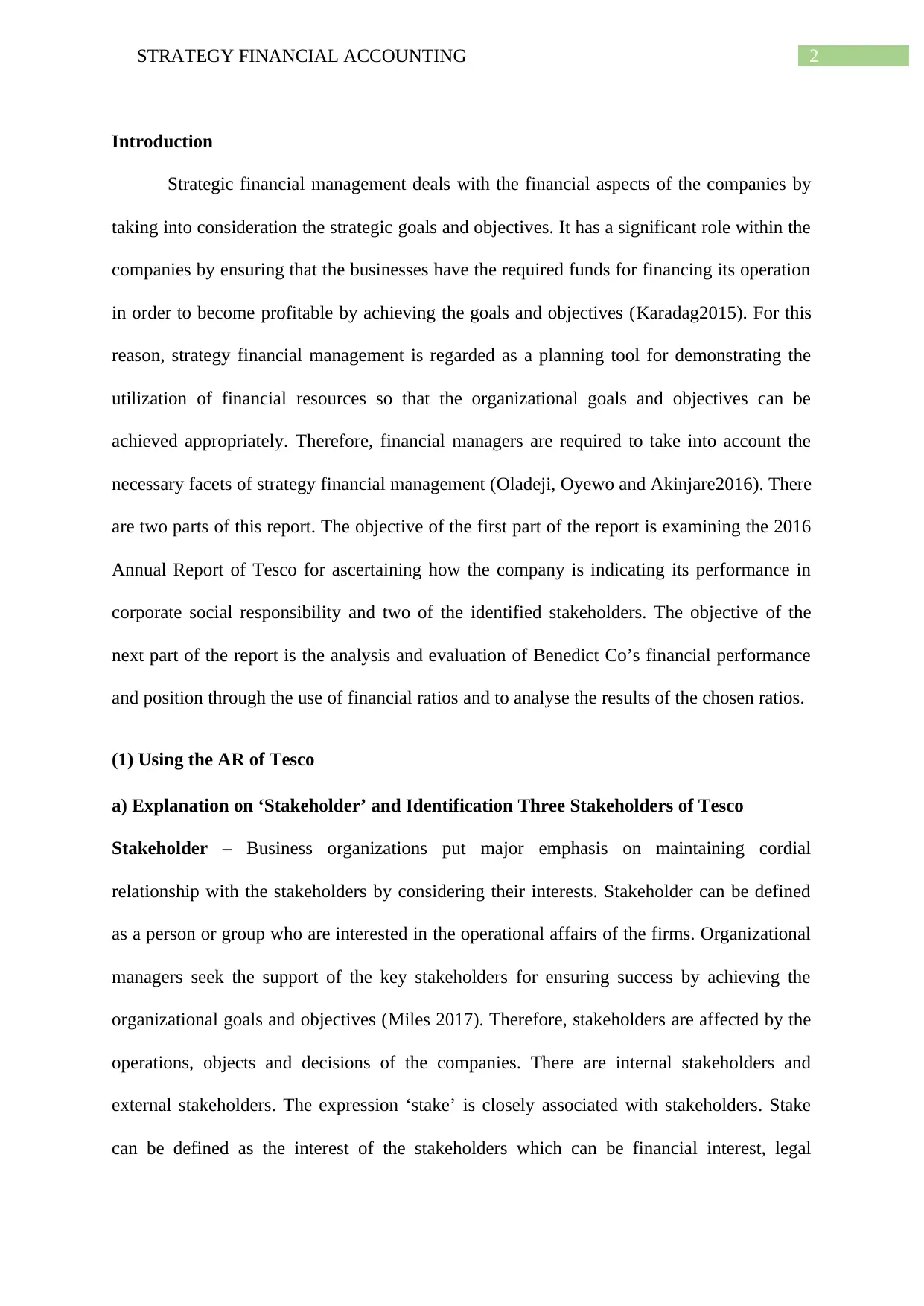
2STRATEGY FINANCIAL ACCOUNTING
Introduction
Strategic financial management deals with the financial aspects of the companies by
taking into consideration the strategic goals and objectives. It has a significant role within the
companies by ensuring that the businesses have the required funds for financing its operation
in order to become profitable by achieving the goals and objectives (Karadag2015). For this
reason, strategy financial management is regarded as a planning tool for demonstrating the
utilization of financial resources so that the organizational goals and objectives can be
achieved appropriately. Therefore, financial managers are required to take into account the
necessary facets of strategy financial management (Oladeji, Oyewo and Akinjare2016). There
are two parts of this report. The objective of the first part of the report is examining the 2016
Annual Report of Tesco for ascertaining how the company is indicating its performance in
corporate social responsibility and two of the identified stakeholders. The objective of the
next part of the report is the analysis and evaluation of Benedict Co’s financial performance
and position through the use of financial ratios and to analyse the results of the chosen ratios.
(1) Using the AR of Tesco
a) Explanation on ‘Stakeholder’ and Identification Three Stakeholders of Tesco
Stakeholder – Business organizations put major emphasis on maintaining cordial
relationship with the stakeholders by considering their interests. Stakeholder can be defined
as a person or group who are interested in the operational affairs of the firms. Organizational
managers seek the support of the key stakeholders for ensuring success by achieving the
organizational goals and objectives (Miles 2017). Therefore, stakeholders are affected by the
operations, objects and decisions of the companies. There are internal stakeholders and
external stakeholders. The expression ‘stake’ is closely associated with stakeholders. Stake
can be defined as the interest of the stakeholders which can be financial interest, legal
Introduction
Strategic financial management deals with the financial aspects of the companies by
taking into consideration the strategic goals and objectives. It has a significant role within the
companies by ensuring that the businesses have the required funds for financing its operation
in order to become profitable by achieving the goals and objectives (Karadag2015). For this
reason, strategy financial management is regarded as a planning tool for demonstrating the
utilization of financial resources so that the organizational goals and objectives can be
achieved appropriately. Therefore, financial managers are required to take into account the
necessary facets of strategy financial management (Oladeji, Oyewo and Akinjare2016). There
are two parts of this report. The objective of the first part of the report is examining the 2016
Annual Report of Tesco for ascertaining how the company is indicating its performance in
corporate social responsibility and two of the identified stakeholders. The objective of the
next part of the report is the analysis and evaluation of Benedict Co’s financial performance
and position through the use of financial ratios and to analyse the results of the chosen ratios.
(1) Using the AR of Tesco
a) Explanation on ‘Stakeholder’ and Identification Three Stakeholders of Tesco
Stakeholder – Business organizations put major emphasis on maintaining cordial
relationship with the stakeholders by considering their interests. Stakeholder can be defined
as a person or group who are interested in the operational affairs of the firms. Organizational
managers seek the support of the key stakeholders for ensuring success by achieving the
organizational goals and objectives (Miles 2017). Therefore, stakeholders are affected by the
operations, objects and decisions of the companies. There are internal stakeholders and
external stakeholders. The expression ‘stake’ is closely associated with stakeholders. Stake
can be defined as the interest of the stakeholders which can be financial interest, legal
⊘ This is a preview!⊘
Do you want full access?
Subscribe today to unlock all pages.

Trusted by 1+ million students worldwide
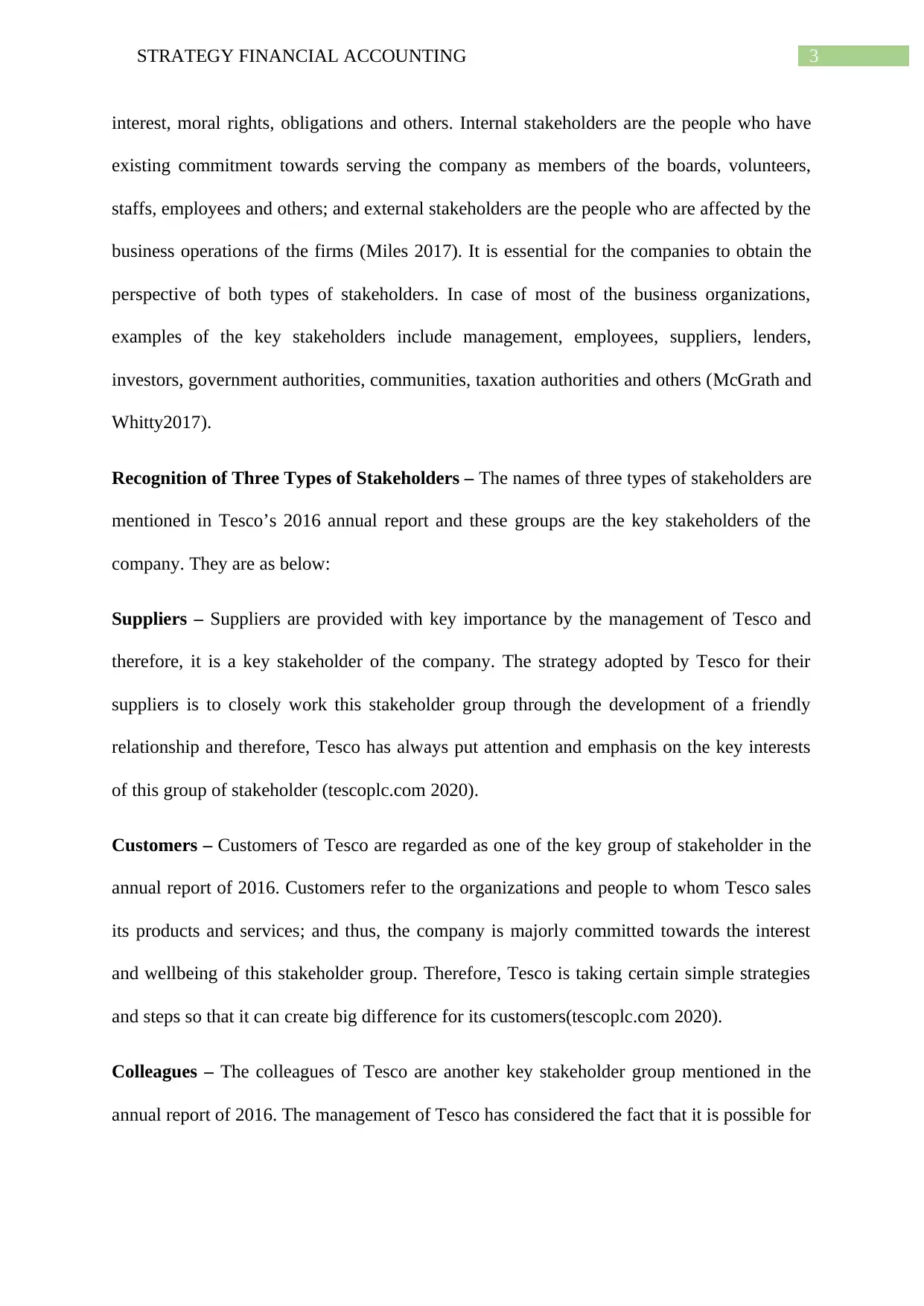
3STRATEGY FINANCIAL ACCOUNTING
interest, moral rights, obligations and others. Internal stakeholders are the people who have
existing commitment towards serving the company as members of the boards, volunteers,
staffs, employees and others; and external stakeholders are the people who are affected by the
business operations of the firms (Miles 2017). It is essential for the companies to obtain the
perspective of both types of stakeholders. In case of most of the business organizations,
examples of the key stakeholders include management, employees, suppliers, lenders,
investors, government authorities, communities, taxation authorities and others (McGrath and
Whitty2017).
Recognition of Three Types of Stakeholders – The names of three types of stakeholders are
mentioned in Tesco’s 2016 annual report and these groups are the key stakeholders of the
company. They are as below:
Suppliers – Suppliers are provided with key importance by the management of Tesco and
therefore, it is a key stakeholder of the company. The strategy adopted by Tesco for their
suppliers is to closely work this stakeholder group through the development of a friendly
relationship and therefore, Tesco has always put attention and emphasis on the key interests
of this group of stakeholder (tescoplc.com 2020).
Customers – Customers of Tesco are regarded as one of the key group of stakeholder in the
annual report of 2016. Customers refer to the organizations and people to whom Tesco sales
its products and services; and thus, the company is majorly committed towards the interest
and wellbeing of this stakeholder group. Therefore, Tesco is taking certain simple strategies
and steps so that it can create big difference for its customers(tescoplc.com 2020).
Colleagues – The colleagues of Tesco are another key stakeholder group mentioned in the
annual report of 2016. The management of Tesco has considered the fact that it is possible for
interest, moral rights, obligations and others. Internal stakeholders are the people who have
existing commitment towards serving the company as members of the boards, volunteers,
staffs, employees and others; and external stakeholders are the people who are affected by the
business operations of the firms (Miles 2017). It is essential for the companies to obtain the
perspective of both types of stakeholders. In case of most of the business organizations,
examples of the key stakeholders include management, employees, suppliers, lenders,
investors, government authorities, communities, taxation authorities and others (McGrath and
Whitty2017).
Recognition of Three Types of Stakeholders – The names of three types of stakeholders are
mentioned in Tesco’s 2016 annual report and these groups are the key stakeholders of the
company. They are as below:
Suppliers – Suppliers are provided with key importance by the management of Tesco and
therefore, it is a key stakeholder of the company. The strategy adopted by Tesco for their
suppliers is to closely work this stakeholder group through the development of a friendly
relationship and therefore, Tesco has always put attention and emphasis on the key interests
of this group of stakeholder (tescoplc.com 2020).
Customers – Customers of Tesco are regarded as one of the key group of stakeholder in the
annual report of 2016. Customers refer to the organizations and people to whom Tesco sales
its products and services; and thus, the company is majorly committed towards the interest
and wellbeing of this stakeholder group. Therefore, Tesco is taking certain simple strategies
and steps so that it can create big difference for its customers(tescoplc.com 2020).
Colleagues – The colleagues of Tesco are another key stakeholder group mentioned in the
annual report of 2016. The management of Tesco has considered the fact that it is possible for
Paraphrase This Document
Need a fresh take? Get an instant paraphrase of this document with our AI Paraphraser
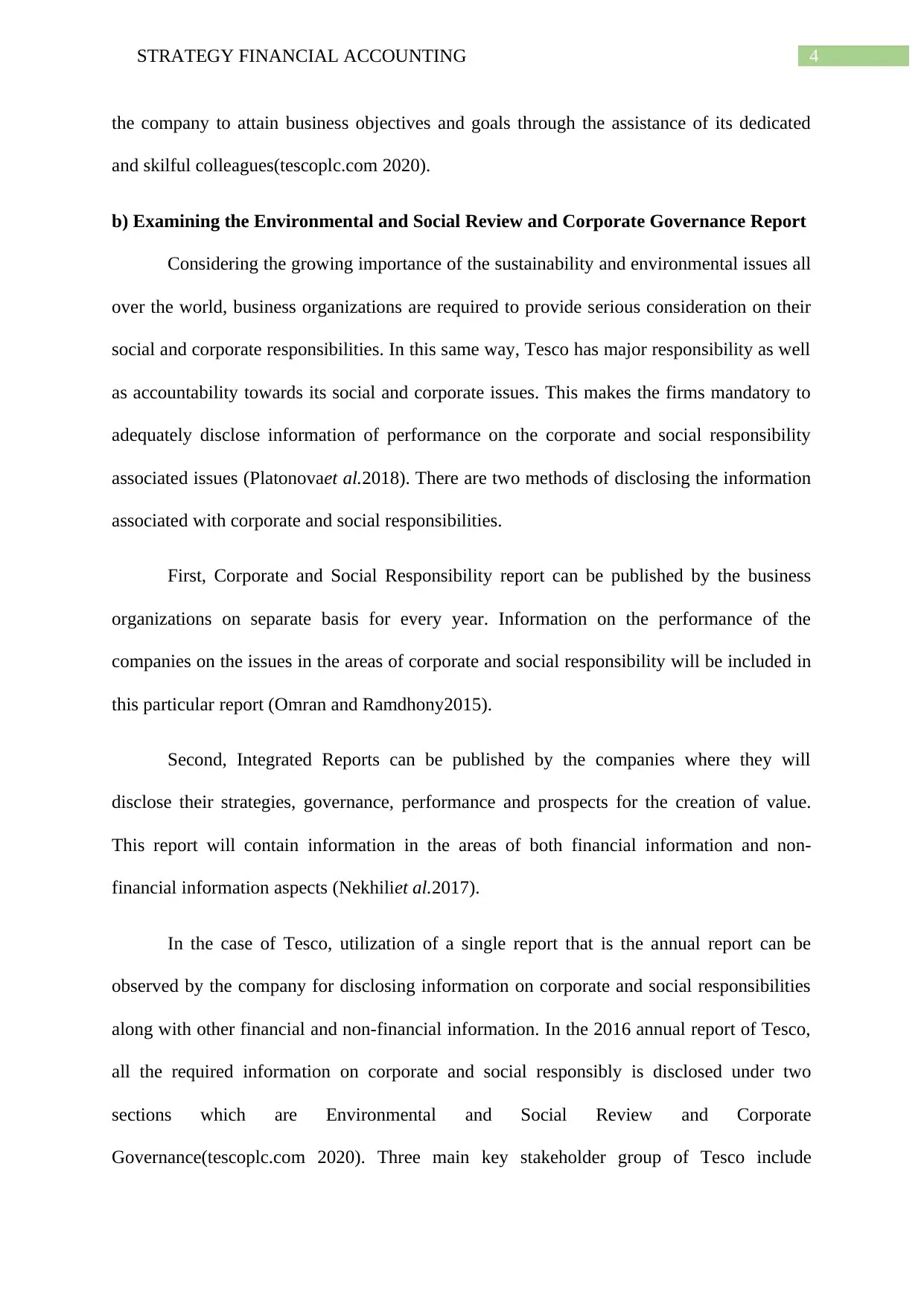
4STRATEGY FINANCIAL ACCOUNTING
the company to attain business objectives and goals through the assistance of its dedicated
and skilful colleagues(tescoplc.com 2020).
b) Examining the Environmental and Social Review and Corporate Governance Report
Considering the growing importance of the sustainability and environmental issues all
over the world, business organizations are required to provide serious consideration on their
social and corporate responsibilities. In this same way, Tesco has major responsibility as well
as accountability towards its social and corporate issues. This makes the firms mandatory to
adequately disclose information of performance on the corporate and social responsibility
associated issues (Platonovaet al.2018). There are two methods of disclosing the information
associated with corporate and social responsibilities.
First, Corporate and Social Responsibility report can be published by the business
organizations on separate basis for every year. Information on the performance of the
companies on the issues in the areas of corporate and social responsibility will be included in
this particular report (Omran and Ramdhony2015).
Second, Integrated Reports can be published by the companies where they will
disclose their strategies, governance, performance and prospects for the creation of value.
This report will contain information in the areas of both financial information and non-
financial information aspects (Nekhiliet al.2017).
In the case of Tesco, utilization of a single report that is the annual report can be
observed by the company for disclosing information on corporate and social responsibilities
along with other financial and non-financial information. In the 2016 annual report of Tesco,
all the required information on corporate and social responsibly is disclosed under two
sections which are Environmental and Social Review and Corporate
Governance(tescoplc.com 2020). Three main key stakeholder group of Tesco include
the company to attain business objectives and goals through the assistance of its dedicated
and skilful colleagues(tescoplc.com 2020).
b) Examining the Environmental and Social Review and Corporate Governance Report
Considering the growing importance of the sustainability and environmental issues all
over the world, business organizations are required to provide serious consideration on their
social and corporate responsibilities. In this same way, Tesco has major responsibility as well
as accountability towards its social and corporate issues. This makes the firms mandatory to
adequately disclose information of performance on the corporate and social responsibility
associated issues (Platonovaet al.2018). There are two methods of disclosing the information
associated with corporate and social responsibilities.
First, Corporate and Social Responsibility report can be published by the business
organizations on separate basis for every year. Information on the performance of the
companies on the issues in the areas of corporate and social responsibility will be included in
this particular report (Omran and Ramdhony2015).
Second, Integrated Reports can be published by the companies where they will
disclose their strategies, governance, performance and prospects for the creation of value.
This report will contain information in the areas of both financial information and non-
financial information aspects (Nekhiliet al.2017).
In the case of Tesco, utilization of a single report that is the annual report can be
observed by the company for disclosing information on corporate and social responsibilities
along with other financial and non-financial information. In the 2016 annual report of Tesco,
all the required information on corporate and social responsibly is disclosed under two
sections which are Environmental and Social Review and Corporate
Governance(tescoplc.com 2020). Three main key stakeholder group of Tesco include
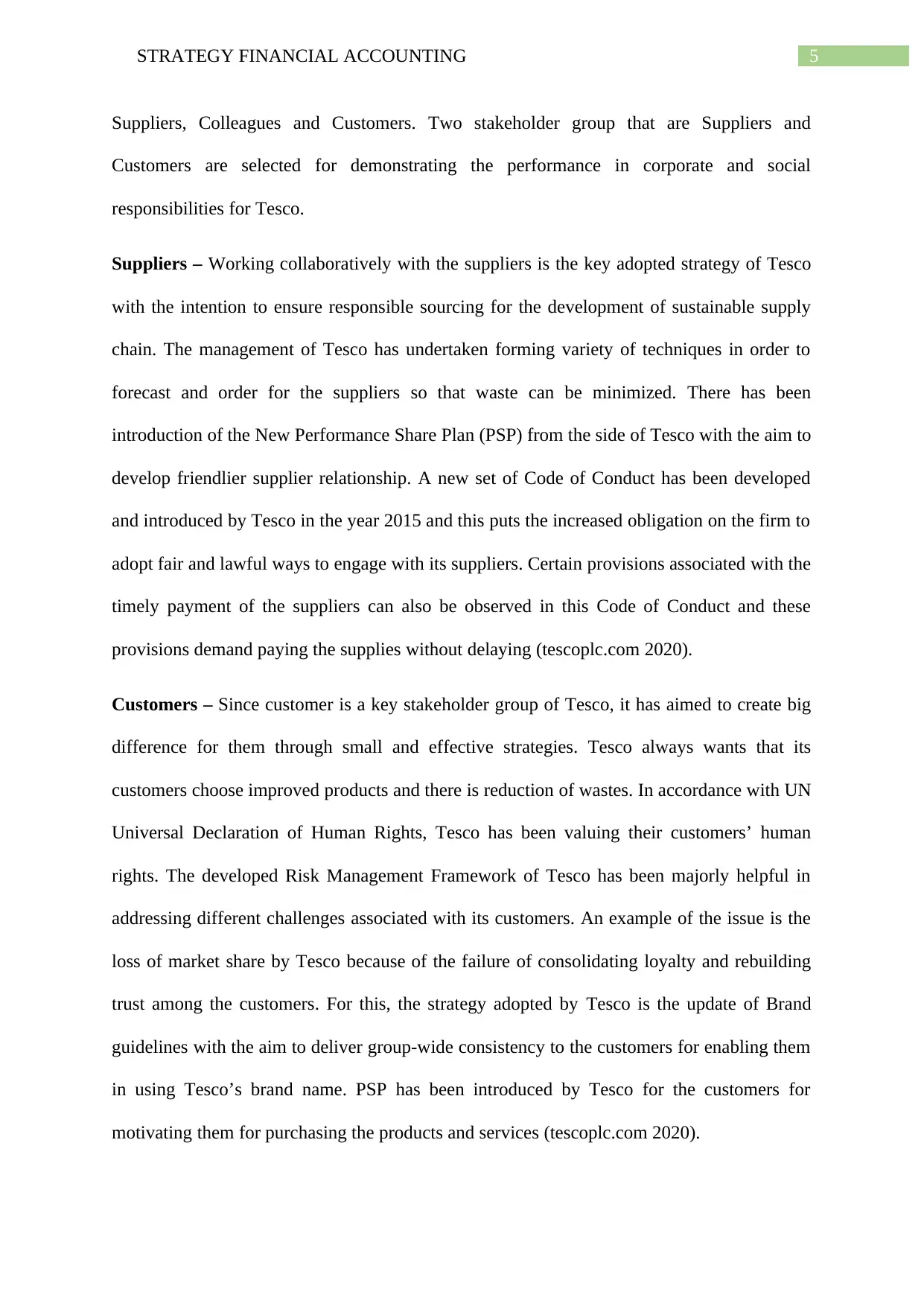
5STRATEGY FINANCIAL ACCOUNTING
Suppliers, Colleagues and Customers. Two stakeholder group that are Suppliers and
Customers are selected for demonstrating the performance in corporate and social
responsibilities for Tesco.
Suppliers – Working collaboratively with the suppliers is the key adopted strategy of Tesco
with the intention to ensure responsible sourcing for the development of sustainable supply
chain. The management of Tesco has undertaken forming variety of techniques in order to
forecast and order for the suppliers so that waste can be minimized. There has been
introduction of the New Performance Share Plan (PSP) from the side of Tesco with the aim to
develop friendlier supplier relationship. A new set of Code of Conduct has been developed
and introduced by Tesco in the year 2015 and this puts the increased obligation on the firm to
adopt fair and lawful ways to engage with its suppliers. Certain provisions associated with the
timely payment of the suppliers can also be observed in this Code of Conduct and these
provisions demand paying the supplies without delaying (tescoplc.com 2020).
Customers – Since customer is a key stakeholder group of Tesco, it has aimed to create big
difference for them through small and effective strategies. Tesco always wants that its
customers choose improved products and there is reduction of wastes. In accordance with UN
Universal Declaration of Human Rights, Tesco has been valuing their customers’ human
rights. The developed Risk Management Framework of Tesco has been majorly helpful in
addressing different challenges associated with its customers. An example of the issue is the
loss of market share by Tesco because of the failure of consolidating loyalty and rebuilding
trust among the customers. For this, the strategy adopted by Tesco is the update of Brand
guidelines with the aim to deliver group-wide consistency to the customers for enabling them
in using Tesco’s brand name. PSP has been introduced by Tesco for the customers for
motivating them for purchasing the products and services (tescoplc.com 2020).
Suppliers, Colleagues and Customers. Two stakeholder group that are Suppliers and
Customers are selected for demonstrating the performance in corporate and social
responsibilities for Tesco.
Suppliers – Working collaboratively with the suppliers is the key adopted strategy of Tesco
with the intention to ensure responsible sourcing for the development of sustainable supply
chain. The management of Tesco has undertaken forming variety of techniques in order to
forecast and order for the suppliers so that waste can be minimized. There has been
introduction of the New Performance Share Plan (PSP) from the side of Tesco with the aim to
develop friendlier supplier relationship. A new set of Code of Conduct has been developed
and introduced by Tesco in the year 2015 and this puts the increased obligation on the firm to
adopt fair and lawful ways to engage with its suppliers. Certain provisions associated with the
timely payment of the suppliers can also be observed in this Code of Conduct and these
provisions demand paying the supplies without delaying (tescoplc.com 2020).
Customers – Since customer is a key stakeholder group of Tesco, it has aimed to create big
difference for them through small and effective strategies. Tesco always wants that its
customers choose improved products and there is reduction of wastes. In accordance with UN
Universal Declaration of Human Rights, Tesco has been valuing their customers’ human
rights. The developed Risk Management Framework of Tesco has been majorly helpful in
addressing different challenges associated with its customers. An example of the issue is the
loss of market share by Tesco because of the failure of consolidating loyalty and rebuilding
trust among the customers. For this, the strategy adopted by Tesco is the update of Brand
guidelines with the aim to deliver group-wide consistency to the customers for enabling them
in using Tesco’s brand name. PSP has been introduced by Tesco for the customers for
motivating them for purchasing the products and services (tescoplc.com 2020).
⊘ This is a preview!⊘
Do you want full access?
Subscribe today to unlock all pages.

Trusted by 1+ million students worldwide
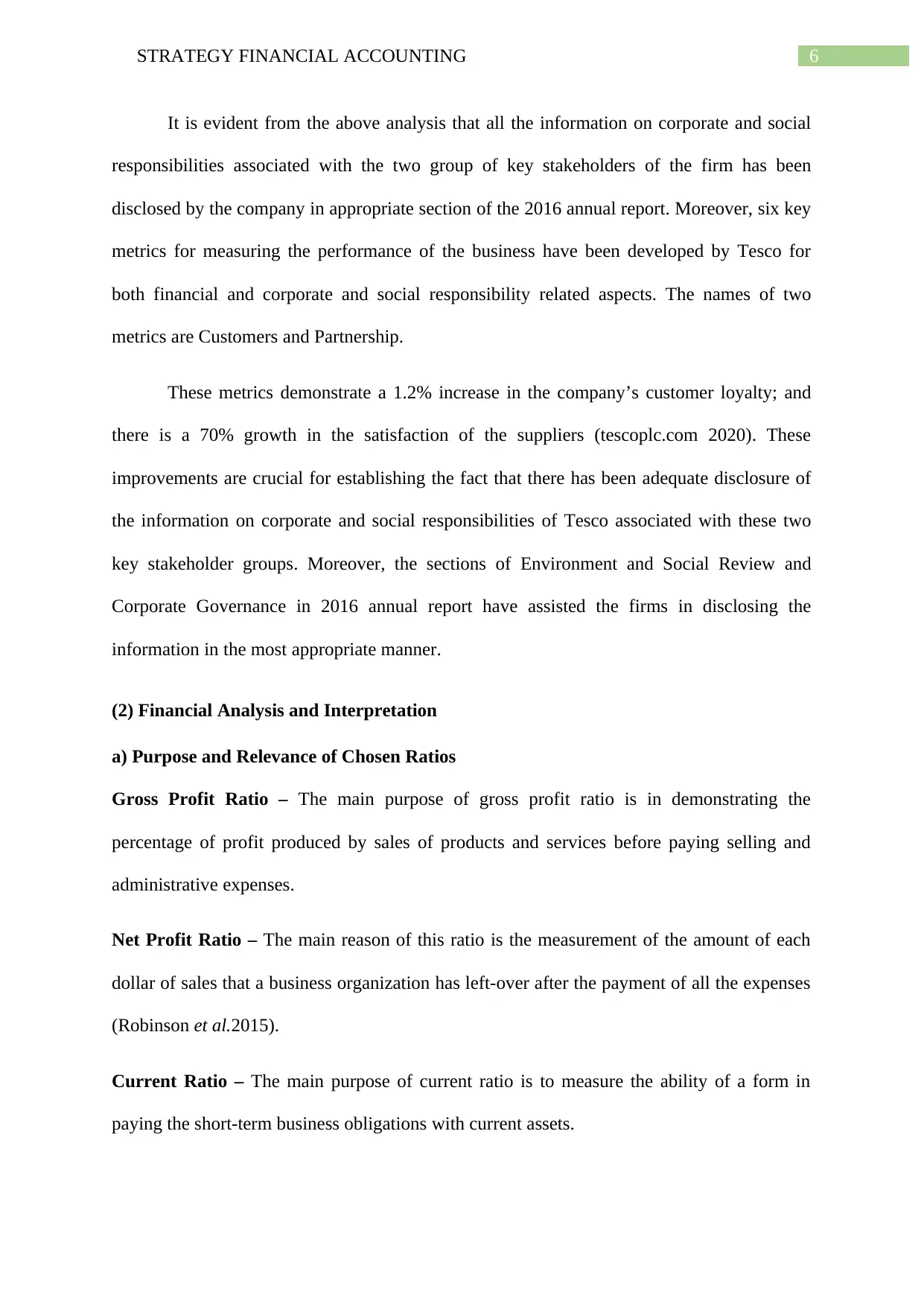
6STRATEGY FINANCIAL ACCOUNTING
It is evident from the above analysis that all the information on corporate and social
responsibilities associated with the two group of key stakeholders of the firm has been
disclosed by the company in appropriate section of the 2016 annual report. Moreover, six key
metrics for measuring the performance of the business have been developed by Tesco for
both financial and corporate and social responsibility related aspects. The names of two
metrics are Customers and Partnership.
These metrics demonstrate a 1.2% increase in the company’s customer loyalty; and
there is a 70% growth in the satisfaction of the suppliers (tescoplc.com 2020). These
improvements are crucial for establishing the fact that there has been adequate disclosure of
the information on corporate and social responsibilities of Tesco associated with these two
key stakeholder groups. Moreover, the sections of Environment and Social Review and
Corporate Governance in 2016 annual report have assisted the firms in disclosing the
information in the most appropriate manner.
(2) Financial Analysis and Interpretation
a) Purpose and Relevance of Chosen Ratios
Gross Profit Ratio – The main purpose of gross profit ratio is in demonstrating the
percentage of profit produced by sales of products and services before paying selling and
administrative expenses.
Net Profit Ratio – The main reason of this ratio is the measurement of the amount of each
dollar of sales that a business organization has left-over after the payment of all the expenses
(Robinson et al.2015).
Current Ratio – The main purpose of current ratio is to measure the ability of a form in
paying the short-term business obligations with current assets.
It is evident from the above analysis that all the information on corporate and social
responsibilities associated with the two group of key stakeholders of the firm has been
disclosed by the company in appropriate section of the 2016 annual report. Moreover, six key
metrics for measuring the performance of the business have been developed by Tesco for
both financial and corporate and social responsibility related aspects. The names of two
metrics are Customers and Partnership.
These metrics demonstrate a 1.2% increase in the company’s customer loyalty; and
there is a 70% growth in the satisfaction of the suppliers (tescoplc.com 2020). These
improvements are crucial for establishing the fact that there has been adequate disclosure of
the information on corporate and social responsibilities of Tesco associated with these two
key stakeholder groups. Moreover, the sections of Environment and Social Review and
Corporate Governance in 2016 annual report have assisted the firms in disclosing the
information in the most appropriate manner.
(2) Financial Analysis and Interpretation
a) Purpose and Relevance of Chosen Ratios
Gross Profit Ratio – The main purpose of gross profit ratio is in demonstrating the
percentage of profit produced by sales of products and services before paying selling and
administrative expenses.
Net Profit Ratio – The main reason of this ratio is the measurement of the amount of each
dollar of sales that a business organization has left-over after the payment of all the expenses
(Robinson et al.2015).
Current Ratio – The main purpose of current ratio is to measure the ability of a form in
paying the short-term business obligations with current assets.
Paraphrase This Document
Need a fresh take? Get an instant paraphrase of this document with our AI Paraphraser
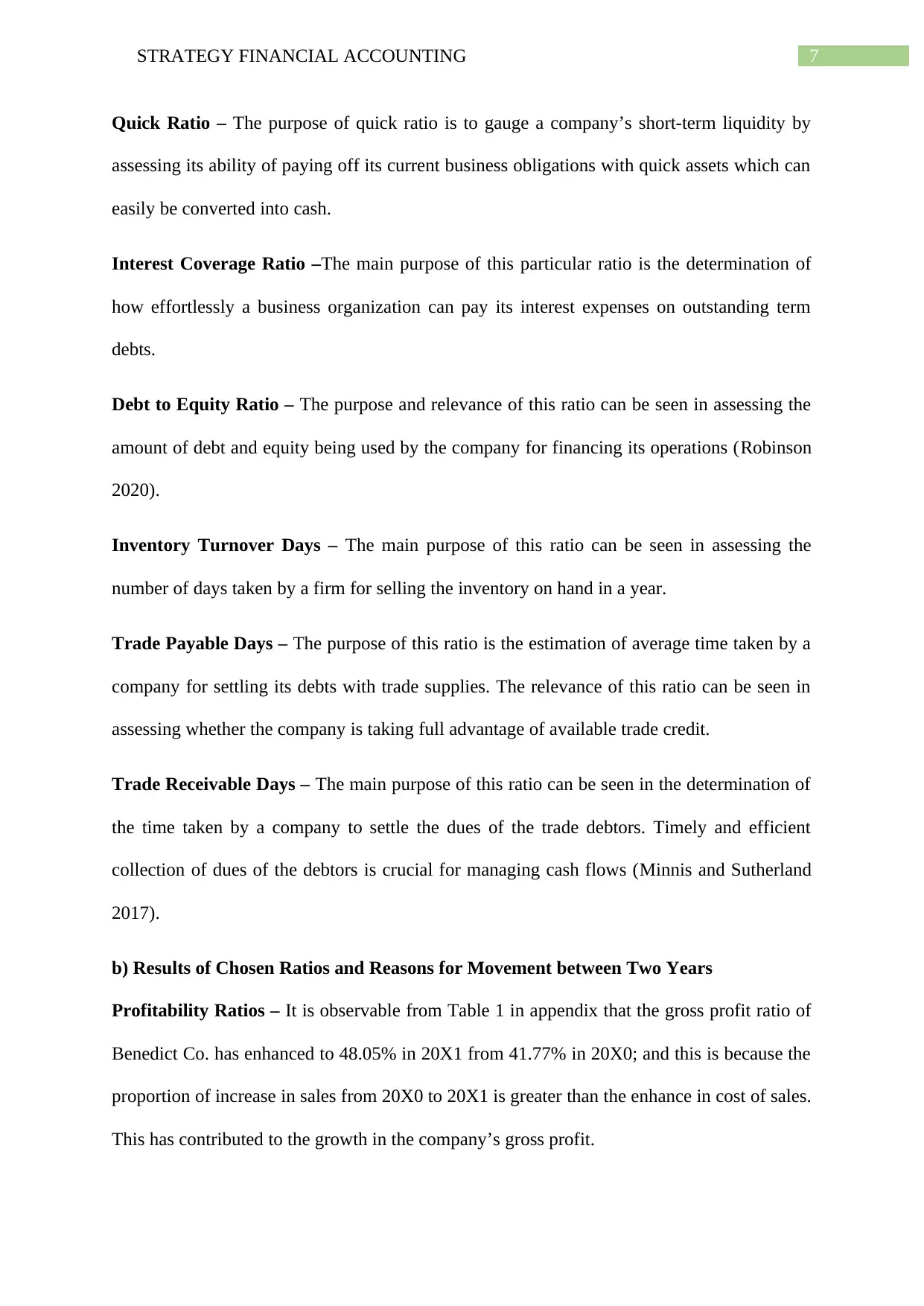
7STRATEGY FINANCIAL ACCOUNTING
Quick Ratio – The purpose of quick ratio is to gauge a company’s short-term liquidity by
assessing its ability of paying off its current business obligations with quick assets which can
easily be converted into cash.
Interest Coverage Ratio –The main purpose of this particular ratio is the determination of
how effortlessly a business organization can pay its interest expenses on outstanding term
debts.
Debt to Equity Ratio – The purpose and relevance of this ratio can be seen in assessing the
amount of debt and equity being used by the company for financing its operations (Robinson
2020).
Inventory Turnover Days – The main purpose of this ratio can be seen in assessing the
number of days taken by a firm for selling the inventory on hand in a year.
Trade Payable Days – The purpose of this ratio is the estimation of average time taken by a
company for settling its debts with trade supplies. The relevance of this ratio can be seen in
assessing whether the company is taking full advantage of available trade credit.
Trade Receivable Days – The main purpose of this ratio can be seen in the determination of
the time taken by a company to settle the dues of the trade debtors. Timely and efficient
collection of dues of the debtors is crucial for managing cash flows (Minnis and Sutherland
2017).
b) Results of Chosen Ratios and Reasons for Movement between Two Years
Profitability Ratios – It is observable from Table 1 in appendix that the gross profit ratio of
Benedict Co. has enhanced to 48.05% in 20X1 from 41.77% in 20X0; and this is because the
proportion of increase in sales from 20X0 to 20X1 is greater than the enhance in cost of sales.
This has contributed to the growth in the company’s gross profit.
Quick Ratio – The purpose of quick ratio is to gauge a company’s short-term liquidity by
assessing its ability of paying off its current business obligations with quick assets which can
easily be converted into cash.
Interest Coverage Ratio –The main purpose of this particular ratio is the determination of
how effortlessly a business organization can pay its interest expenses on outstanding term
debts.
Debt to Equity Ratio – The purpose and relevance of this ratio can be seen in assessing the
amount of debt and equity being used by the company for financing its operations (Robinson
2020).
Inventory Turnover Days – The main purpose of this ratio can be seen in assessing the
number of days taken by a firm for selling the inventory on hand in a year.
Trade Payable Days – The purpose of this ratio is the estimation of average time taken by a
company for settling its debts with trade supplies. The relevance of this ratio can be seen in
assessing whether the company is taking full advantage of available trade credit.
Trade Receivable Days – The main purpose of this ratio can be seen in the determination of
the time taken by a company to settle the dues of the trade debtors. Timely and efficient
collection of dues of the debtors is crucial for managing cash flows (Minnis and Sutherland
2017).
b) Results of Chosen Ratios and Reasons for Movement between Two Years
Profitability Ratios – It is observable from Table 1 in appendix that the gross profit ratio of
Benedict Co. has enhanced to 48.05% in 20X1 from 41.77% in 20X0; and this is because the
proportion of increase in sales from 20X0 to 20X1 is greater than the enhance in cost of sales.
This has contributed to the growth in the company’s gross profit.
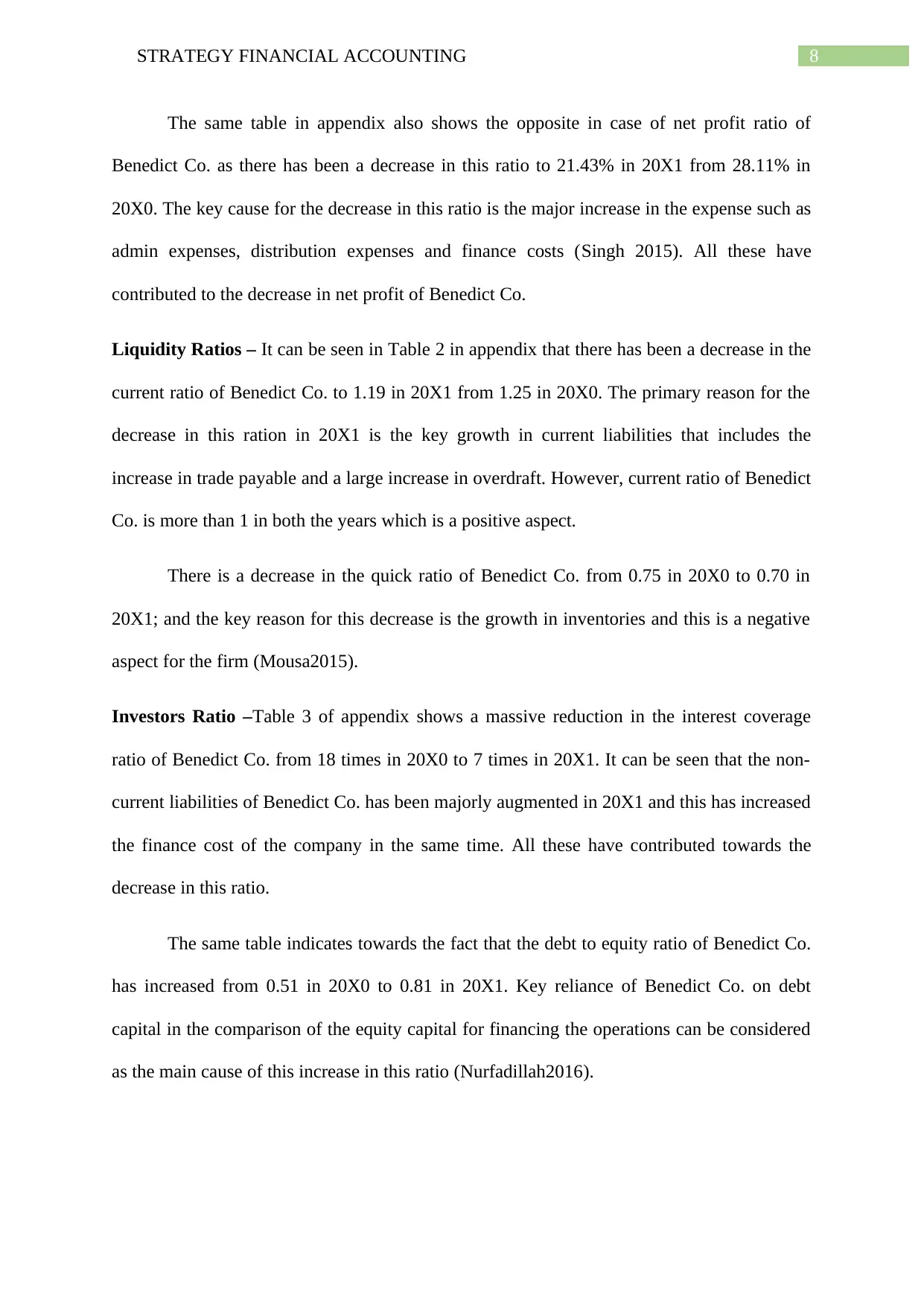
8STRATEGY FINANCIAL ACCOUNTING
The same table in appendix also shows the opposite in case of net profit ratio of
Benedict Co. as there has been a decrease in this ratio to 21.43% in 20X1 from 28.11% in
20X0. The key cause for the decrease in this ratio is the major increase in the expense such as
admin expenses, distribution expenses and finance costs (Singh 2015). All these have
contributed to the decrease in net profit of Benedict Co.
Liquidity Ratios – It can be seen in Table 2 in appendix that there has been a decrease in the
current ratio of Benedict Co. to 1.19 in 20X1 from 1.25 in 20X0. The primary reason for the
decrease in this ration in 20X1 is the key growth in current liabilities that includes the
increase in trade payable and a large increase in overdraft. However, current ratio of Benedict
Co. is more than 1 in both the years which is a positive aspect.
There is a decrease in the quick ratio of Benedict Co. from 0.75 in 20X0 to 0.70 in
20X1; and the key reason for this decrease is the growth in inventories and this is a negative
aspect for the firm (Mousa2015).
Investors Ratio –Table 3 of appendix shows a massive reduction in the interest coverage
ratio of Benedict Co. from 18 times in 20X0 to 7 times in 20X1. It can be seen that the non-
current liabilities of Benedict Co. has been majorly augmented in 20X1 and this has increased
the finance cost of the company in the same time. All these have contributed towards the
decrease in this ratio.
The same table indicates towards the fact that the debt to equity ratio of Benedict Co.
has increased from 0.51 in 20X0 to 0.81 in 20X1. Key reliance of Benedict Co. on debt
capital in the comparison of the equity capital for financing the operations can be considered
as the main cause of this increase in this ratio (Nurfadillah2016).
The same table in appendix also shows the opposite in case of net profit ratio of
Benedict Co. as there has been a decrease in this ratio to 21.43% in 20X1 from 28.11% in
20X0. The key cause for the decrease in this ratio is the major increase in the expense such as
admin expenses, distribution expenses and finance costs (Singh 2015). All these have
contributed to the decrease in net profit of Benedict Co.
Liquidity Ratios – It can be seen in Table 2 in appendix that there has been a decrease in the
current ratio of Benedict Co. to 1.19 in 20X1 from 1.25 in 20X0. The primary reason for the
decrease in this ration in 20X1 is the key growth in current liabilities that includes the
increase in trade payable and a large increase in overdraft. However, current ratio of Benedict
Co. is more than 1 in both the years which is a positive aspect.
There is a decrease in the quick ratio of Benedict Co. from 0.75 in 20X0 to 0.70 in
20X1; and the key reason for this decrease is the growth in inventories and this is a negative
aspect for the firm (Mousa2015).
Investors Ratio –Table 3 of appendix shows a massive reduction in the interest coverage
ratio of Benedict Co. from 18 times in 20X0 to 7 times in 20X1. It can be seen that the non-
current liabilities of Benedict Co. has been majorly augmented in 20X1 and this has increased
the finance cost of the company in the same time. All these have contributed towards the
decrease in this ratio.
The same table indicates towards the fact that the debt to equity ratio of Benedict Co.
has increased from 0.51 in 20X0 to 0.81 in 20X1. Key reliance of Benedict Co. on debt
capital in the comparison of the equity capital for financing the operations can be considered
as the main cause of this increase in this ratio (Nurfadillah2016).
⊘ This is a preview!⊘
Do you want full access?
Subscribe today to unlock all pages.

Trusted by 1+ million students worldwide
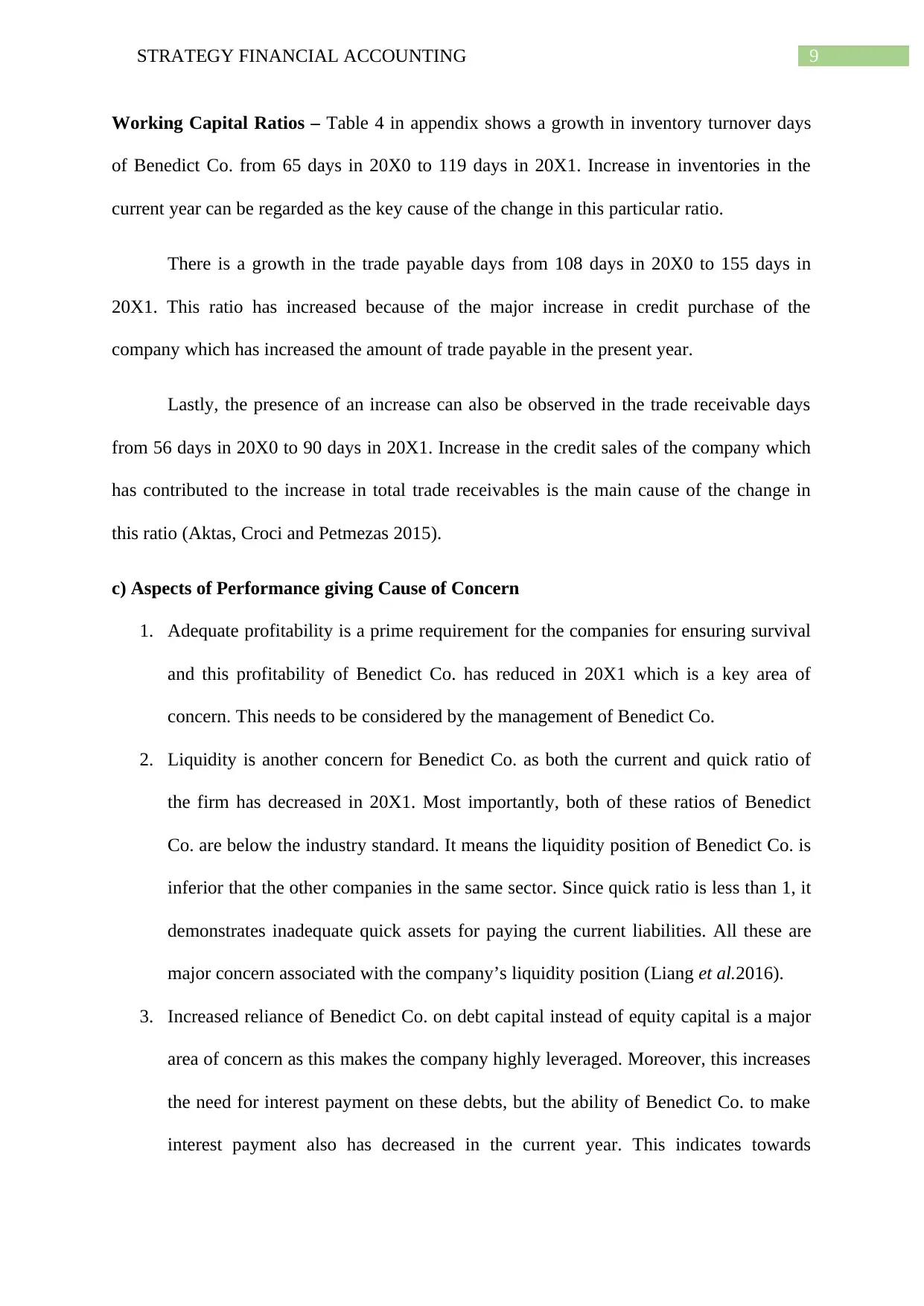
9STRATEGY FINANCIAL ACCOUNTING
Working Capital Ratios – Table 4 in appendix shows a growth in inventory turnover days
of Benedict Co. from 65 days in 20X0 to 119 days in 20X1. Increase in inventories in the
current year can be regarded as the key cause of the change in this particular ratio.
There is a growth in the trade payable days from 108 days in 20X0 to 155 days in
20X1. This ratio has increased because of the major increase in credit purchase of the
company which has increased the amount of trade payable in the present year.
Lastly, the presence of an increase can also be observed in the trade receivable days
from 56 days in 20X0 to 90 days in 20X1. Increase in the credit sales of the company which
has contributed to the increase in total trade receivables is the main cause of the change in
this ratio (Aktas, Croci and Petmezas 2015).
c) Aspects of Performance giving Cause of Concern
1. Adequate profitability is a prime requirement for the companies for ensuring survival
and this profitability of Benedict Co. has reduced in 20X1 which is a key area of
concern. This needs to be considered by the management of Benedict Co.
2. Liquidity is another concern for Benedict Co. as both the current and quick ratio of
the firm has decreased in 20X1. Most importantly, both of these ratios of Benedict
Co. are below the industry standard. It means the liquidity position of Benedict Co. is
inferior that the other companies in the same sector. Since quick ratio is less than 1, it
demonstrates inadequate quick assets for paying the current liabilities. All these are
major concern associated with the company’s liquidity position (Liang et al.2016).
3. Increased reliance of Benedict Co. on debt capital instead of equity capital is a major
area of concern as this makes the company highly leveraged. Moreover, this increases
the need for interest payment on these debts, but the ability of Benedict Co. to make
interest payment also has decreased in the current year. This indicates towards
Working Capital Ratios – Table 4 in appendix shows a growth in inventory turnover days
of Benedict Co. from 65 days in 20X0 to 119 days in 20X1. Increase in inventories in the
current year can be regarded as the key cause of the change in this particular ratio.
There is a growth in the trade payable days from 108 days in 20X0 to 155 days in
20X1. This ratio has increased because of the major increase in credit purchase of the
company which has increased the amount of trade payable in the present year.
Lastly, the presence of an increase can also be observed in the trade receivable days
from 56 days in 20X0 to 90 days in 20X1. Increase in the credit sales of the company which
has contributed to the increase in total trade receivables is the main cause of the change in
this ratio (Aktas, Croci and Petmezas 2015).
c) Aspects of Performance giving Cause of Concern
1. Adequate profitability is a prime requirement for the companies for ensuring survival
and this profitability of Benedict Co. has reduced in 20X1 which is a key area of
concern. This needs to be considered by the management of Benedict Co.
2. Liquidity is another concern for Benedict Co. as both the current and quick ratio of
the firm has decreased in 20X1. Most importantly, both of these ratios of Benedict
Co. are below the industry standard. It means the liquidity position of Benedict Co. is
inferior that the other companies in the same sector. Since quick ratio is less than 1, it
demonstrates inadequate quick assets for paying the current liabilities. All these are
major concern associated with the company’s liquidity position (Liang et al.2016).
3. Increased reliance of Benedict Co. on debt capital instead of equity capital is a major
area of concern as this makes the company highly leveraged. Moreover, this increases
the need for interest payment on these debts, but the ability of Benedict Co. to make
interest payment also has decreased in the current year. This indicates towards
Paraphrase This Document
Need a fresh take? Get an instant paraphrase of this document with our AI Paraphraser
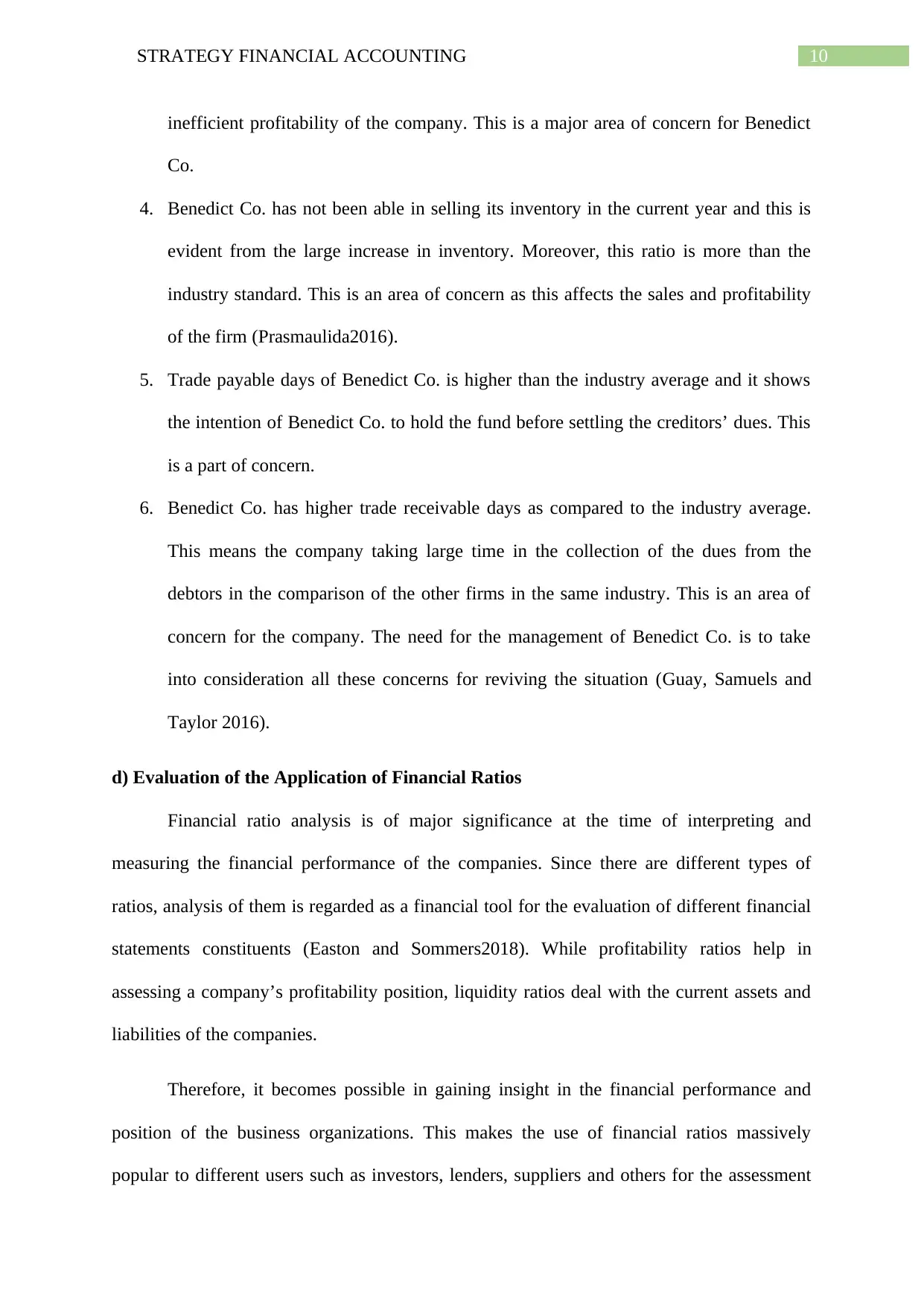
10STRATEGY FINANCIAL ACCOUNTING
inefficient profitability of the company. This is a major area of concern for Benedict
Co.
4. Benedict Co. has not been able in selling its inventory in the current year and this is
evident from the large increase in inventory. Moreover, this ratio is more than the
industry standard. This is an area of concern as this affects the sales and profitability
of the firm (Prasmaulida2016).
5. Trade payable days of Benedict Co. is higher than the industry average and it shows
the intention of Benedict Co. to hold the fund before settling the creditors’ dues. This
is a part of concern.
6. Benedict Co. has higher trade receivable days as compared to the industry average.
This means the company taking large time in the collection of the dues from the
debtors in the comparison of the other firms in the same industry. This is an area of
concern for the company. The need for the management of Benedict Co. is to take
into consideration all these concerns for reviving the situation (Guay, Samuels and
Taylor 2016).
d) Evaluation of the Application of Financial Ratios
Financial ratio analysis is of major significance at the time of interpreting and
measuring the financial performance of the companies. Since there are different types of
ratios, analysis of them is regarded as a financial tool for the evaluation of different financial
statements constituents (Easton and Sommers2018). While profitability ratios help in
assessing a company’s profitability position, liquidity ratios deal with the current assets and
liabilities of the companies.
Therefore, it becomes possible in gaining insight in the financial performance and
position of the business organizations. This makes the use of financial ratios massively
popular to different users such as investors, lenders, suppliers and others for the assessment
inefficient profitability of the company. This is a major area of concern for Benedict
Co.
4. Benedict Co. has not been able in selling its inventory in the current year and this is
evident from the large increase in inventory. Moreover, this ratio is more than the
industry standard. This is an area of concern as this affects the sales and profitability
of the firm (Prasmaulida2016).
5. Trade payable days of Benedict Co. is higher than the industry average and it shows
the intention of Benedict Co. to hold the fund before settling the creditors’ dues. This
is a part of concern.
6. Benedict Co. has higher trade receivable days as compared to the industry average.
This means the company taking large time in the collection of the dues from the
debtors in the comparison of the other firms in the same industry. This is an area of
concern for the company. The need for the management of Benedict Co. is to take
into consideration all these concerns for reviving the situation (Guay, Samuels and
Taylor 2016).
d) Evaluation of the Application of Financial Ratios
Financial ratio analysis is of major significance at the time of interpreting and
measuring the financial performance of the companies. Since there are different types of
ratios, analysis of them is regarded as a financial tool for the evaluation of different financial
statements constituents (Easton and Sommers2018). While profitability ratios help in
assessing a company’s profitability position, liquidity ratios deal with the current assets and
liabilities of the companies.
Therefore, it becomes possible in gaining insight in the financial performance and
position of the business organizations. This makes the use of financial ratios massively
popular to different users such as investors, lenders, suppliers and others for the assessment
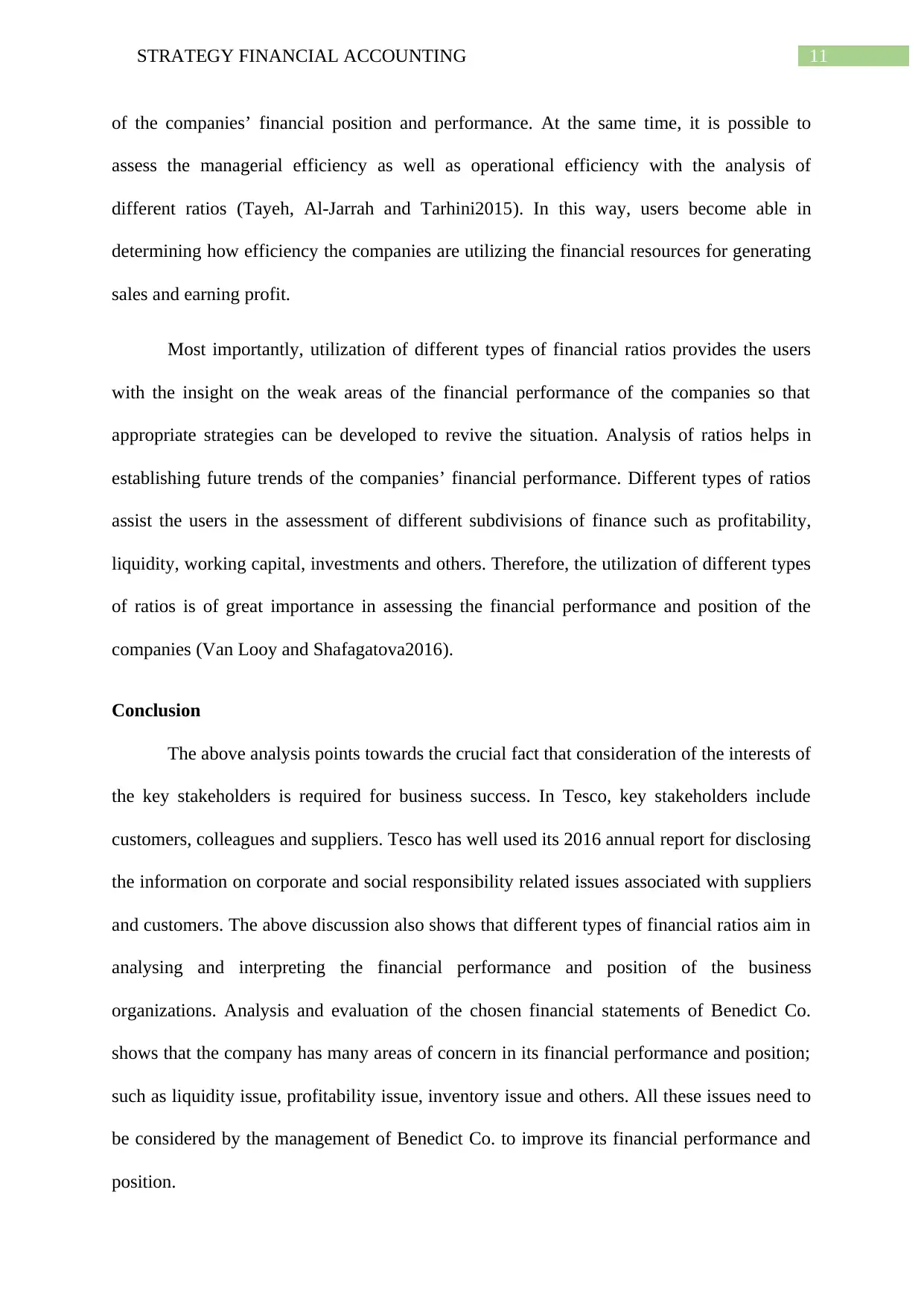
11STRATEGY FINANCIAL ACCOUNTING
of the companies’ financial position and performance. At the same time, it is possible to
assess the managerial efficiency as well as operational efficiency with the analysis of
different ratios (Tayeh, Al-Jarrah and Tarhini2015). In this way, users become able in
determining how efficiency the companies are utilizing the financial resources for generating
sales and earning profit.
Most importantly, utilization of different types of financial ratios provides the users
with the insight on the weak areas of the financial performance of the companies so that
appropriate strategies can be developed to revive the situation. Analysis of ratios helps in
establishing future trends of the companies’ financial performance. Different types of ratios
assist the users in the assessment of different subdivisions of finance such as profitability,
liquidity, working capital, investments and others. Therefore, the utilization of different types
of ratios is of great importance in assessing the financial performance and position of the
companies (Van Looy and Shafagatova2016).
Conclusion
The above analysis points towards the crucial fact that consideration of the interests of
the key stakeholders is required for business success. In Tesco, key stakeholders include
customers, colleagues and suppliers. Tesco has well used its 2016 annual report for disclosing
the information on corporate and social responsibility related issues associated with suppliers
and customers. The above discussion also shows that different types of financial ratios aim in
analysing and interpreting the financial performance and position of the business
organizations. Analysis and evaluation of the chosen financial statements of Benedict Co.
shows that the company has many areas of concern in its financial performance and position;
such as liquidity issue, profitability issue, inventory issue and others. All these issues need to
be considered by the management of Benedict Co. to improve its financial performance and
position.
of the companies’ financial position and performance. At the same time, it is possible to
assess the managerial efficiency as well as operational efficiency with the analysis of
different ratios (Tayeh, Al-Jarrah and Tarhini2015). In this way, users become able in
determining how efficiency the companies are utilizing the financial resources for generating
sales and earning profit.
Most importantly, utilization of different types of financial ratios provides the users
with the insight on the weak areas of the financial performance of the companies so that
appropriate strategies can be developed to revive the situation. Analysis of ratios helps in
establishing future trends of the companies’ financial performance. Different types of ratios
assist the users in the assessment of different subdivisions of finance such as profitability,
liquidity, working capital, investments and others. Therefore, the utilization of different types
of ratios is of great importance in assessing the financial performance and position of the
companies (Van Looy and Shafagatova2016).
Conclusion
The above analysis points towards the crucial fact that consideration of the interests of
the key stakeholders is required for business success. In Tesco, key stakeholders include
customers, colleagues and suppliers. Tesco has well used its 2016 annual report for disclosing
the information on corporate and social responsibility related issues associated with suppliers
and customers. The above discussion also shows that different types of financial ratios aim in
analysing and interpreting the financial performance and position of the business
organizations. Analysis and evaluation of the chosen financial statements of Benedict Co.
shows that the company has many areas of concern in its financial performance and position;
such as liquidity issue, profitability issue, inventory issue and others. All these issues need to
be considered by the management of Benedict Co. to improve its financial performance and
position.
⊘ This is a preview!⊘
Do you want full access?
Subscribe today to unlock all pages.

Trusted by 1+ million students worldwide
1 out of 17
Related Documents
Your All-in-One AI-Powered Toolkit for Academic Success.
+13062052269
info@desklib.com
Available 24*7 on WhatsApp / Email
![[object Object]](/_next/static/media/star-bottom.7253800d.svg)
Unlock your academic potential
Copyright © 2020–2025 A2Z Services. All Rights Reserved. Developed and managed by ZUCOL.





